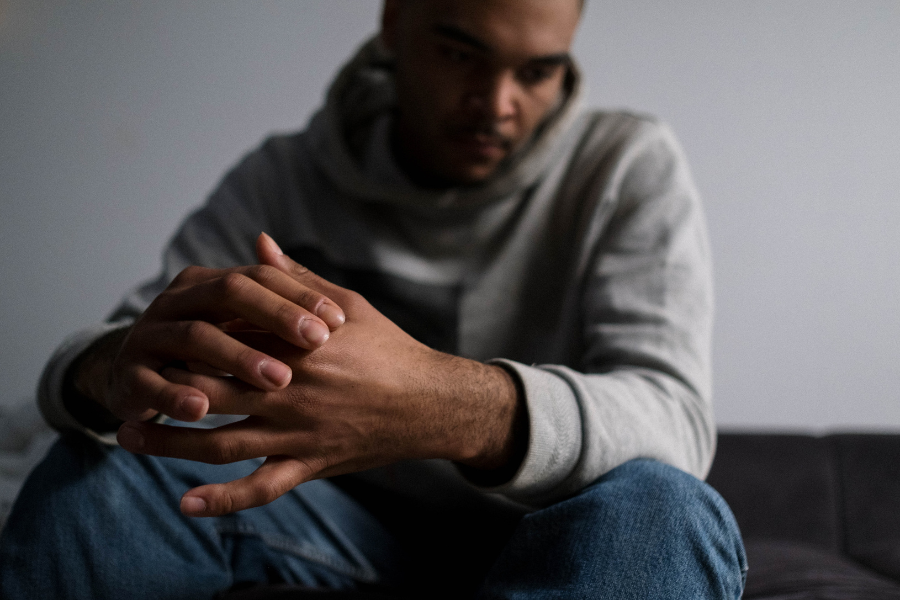There are two triggers for sleep.
The first trigger is one that we all know about: feeling tired and knowing you need to head off to bed.
The other one is a bit more unfamiliar: your body needs to be in a state of muscle relaxation before you fall asleep.
So, if you are very tired but feeling tense or preoccupied with thinking, worrying and planning, it may be harder to fall asleep, stay asleep or get back to sleep after waking very early.
Skip to section
ToggleChanges in Your Sleep Pattern After a Loss
Experiencing a loss of a loved one and grief can result in nightmares or dreaming about the event/s, which in turn can lead to having a shorter or poorer sleep.
Your night-time routines can also be impacted, you might be putting off going to bed, staying up until the early hours of the morning and then sleeping for a substantial part of the following day, or napping during the day and not being able to sleep at night.
Trouble with Getting to Sleep
When you go to bed, it may be the first time in the day you have been alone with your thoughts and without the stimulation, noise and action of the everyday, there is nothing to distract you from difficult and distressing thoughts.
So you may find yourself thinking, planning and worrying. Some people describe this as though they have just switched on a lightbulb in their head and are unable to turn it off. Often, a person will identify that just before they go to bed, they are feeling exhausted, and once in bed, they suddenly feel alert, with their mind racing and unable to sleep.
You may find yourself tossing and turning or just lying awake staring at the ceiling, causing your body to go into a state of muscle tension and keeping you awake.
Trouble With Staying Asleep
Disruptions to different parts of the sleep cycle can also occur. Whereas some people may find it challenging to fall asleep, others may have difficulty staying asleep. You might wake up during the night without a reason, or wake up too early, unable to go back to sleep.
Some people are woken due to environmental factors such as heat, cold or noise, or they wake up to think, worry and plan, especially soon after the loss.
Others may find themselves waking up and just lying there, without anything particular to worry about but with a sense of alertness and feeling that they are unable to go back to sleep.
You end up feeling tired in the morning, some even describe the sensation like having run a marathon overnight.
How do I change the way I’m sleeping?
Changes in your sleep cycle are completely normal and to be expected. The good news is that there are things you can do to resume the old sleep cycle you enjoyed prior to your experience of loss when you may have been waking up feeling refreshed and rested.
You can start with a sleep diary, to track how you sleep, when you go to bed, what time you wake up and how you feel when you wake up. Your present sleep pattern may come as a surprise to you.
Then, follow our three-step guide to dealing with insomnia.
Step 1: Sleep Preparation
Sleep checklist for a better night’s sleep
- Avoid alcohol and smoking: Try to avoid alcohol or smoking for three hours before bedtime to help your body wind down naturally.
- Consistent Bedtime: Aim to go to bed at the same time every night for 3-4 weeks. Consistency can help regulate your sleep cycle.
- Limit caffeine intake: Avoid caffeine after 4pm, including coffee, chocolate, soft drinks, energy drinks, and teas. This can help prevent sleep disruptions.
- Watch sugar intake: Try not to consume food with added sugar at least three hours before bedtime to avoid a sugar rush that might keep you awake.
- Dinner timing: Have your dinner around 3-4 hours before bed. A lighter supper can prevent discomfort and help you sleep better.
- Avoid clock-watching: Resist checking the time overnight. Focusing on the clock can make you more alert and anxious. Consider placing your clock or phone in a drawer or turning it away from you.
- Exercise timing: Avoid exercising close to bedtime as it can wake you up. Try to finish your workout at least five hours before bed.
- Limit evening drinks: Avoid drinking anything, including water, for two hours before bed to reduce nighttime awakenings. Drink plenty of water during the day and stop around 7:30 pm – 8 pm. If you’re thirsty, swish water in your mouth and spit it out to trick your brain into feeling less thirsty.
- Television watching: It’s okay to watch TV as it’s a passive activity. Just try to avoid horror or cliffhanger thrillers that might be too stimulating.
- Reading in bed: Reading can be a good way to relax, but try to choose something light or enjoyable rather than work-related or thrilling material.
- Create a dark, cool environment: Ensure your bedroom is very dark when you go to bed. If you need to get up overnight, avoid checking the time to maintain your sleep rhythm.
Step 2: Set up Positive Sleep Patterns
When you haven’t slept well overnight it’s tempting to stay in bed during the day or fall asleep on your bed during the day. Just use your bed to sleep in overnight. If you start to feel sleepy during the day, wake yourself up by doing something active, preferably something you enjoy. You can also splash cold water on your face.
Falling asleep during the day continues to disrupt your sleep cycle, which has a negative impact on your sleep overnight. While it’s hard not to give in and fall asleep, it’s very important that you put off falling asleep until your natural sleep time at night.
Step 3: Decrease the Tension
When you do go to bed, it may be the first time in the day you have been alone with your thoughts and without the stimulation, noise and action of every day, where there is nothing to distract you from difficult and distressing thoughts.
This can be due to negative beliefs. Some people believe they don’t have the right to a good night’s sleep, others think they are incapable of getting to sleep. These beliefs can also produce physical symptoms, putting the body in a state of muscle tension – a major factor in preventing sleep. The tenser you become the more impossible it is to fall asleep.
To gain more control over your sleep, increase your awareness of how tense you are, prior to going to sleep and practice the following technique to decrease the tension.
Relaxation Techniques for Going to Sleep
Focus on a time in your life when you felt happy, content, relaxed and safe. These four states can induce muscle relaxation and trigger sleep. At first, you may find your mind wandering. If this happens, remind yourself, this is very normal and take yourself back to the beginning of the exercise. The sensation of frustration should pass.
As soon as you are in bed, with the lights out, in a comfortable position and ready to go to sleep, start the relaxation technique. As stated earlier, if you find your mind wandering, this is to be expected, bring yourself back gently to the beginning of the exercise and start again.
Don’t get trapped into feeling frustrated if this happens, as it is completely normal. If you feel frustrated, your body will naturally enter a state of muscle tension, preventing sleep even further.
If you find yourself experiencing negative thoughts, recognise that these thoughts will pass and it is to be expected that you may experience them. When you first start doing this exercise at night, you may have to bring yourself back to the beginning of the exercise a few times.
Once again, this is normal and each night you practice this, it should decrease. If you fall asleep while doing the exercise, that is great, it means it’s working!
Practice the steps
If you have been following the instructions on eating, drinking and preparation for sleep, you may notice that the number of times you wake up and the times you wake up overnight starts to change and decrease. If you do happen to wake up overnight, practice the relaxation technique.
The most important aspect of changing your sleep pattern back to waking up feeling rested and refreshed is CONSISTENCY.
Follow the steps every day, without exception, for three to four weeks to positively change your sleep patterns. You’ll start to notice changes in your sleep and feel much better after the first week.
Related resources:
- Tips to Improve Your Sleep Having difficulty sleeping? Changes to your sleep patterns is common...
- A gentle guide to self-care after loss: The E.A.S.T. approach Helping you connect with healthy routines to give you a...
- Rest and Relaxation Techniques When someone you care about is experiencing grief and loss,...
- Coping with Grief Losing someone or something we treasure can leave you feeling...
- Experiences of Grief Grief is a universal human experience affecting each of us...
- The Different Types of Grief Grief and loss come in many forms and we all...
- Navigating vicarious trauma: Coping with the emotional toll of witnessing other’s trauma Witnessing others' trauma takes a toll on our emotional wellbeing,...
- Major Transitions in Life Change is unavoidable. Sometimes it is planned and other times...












